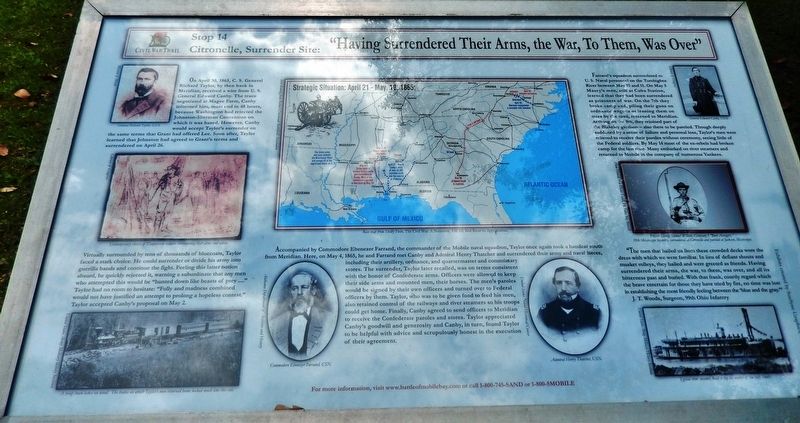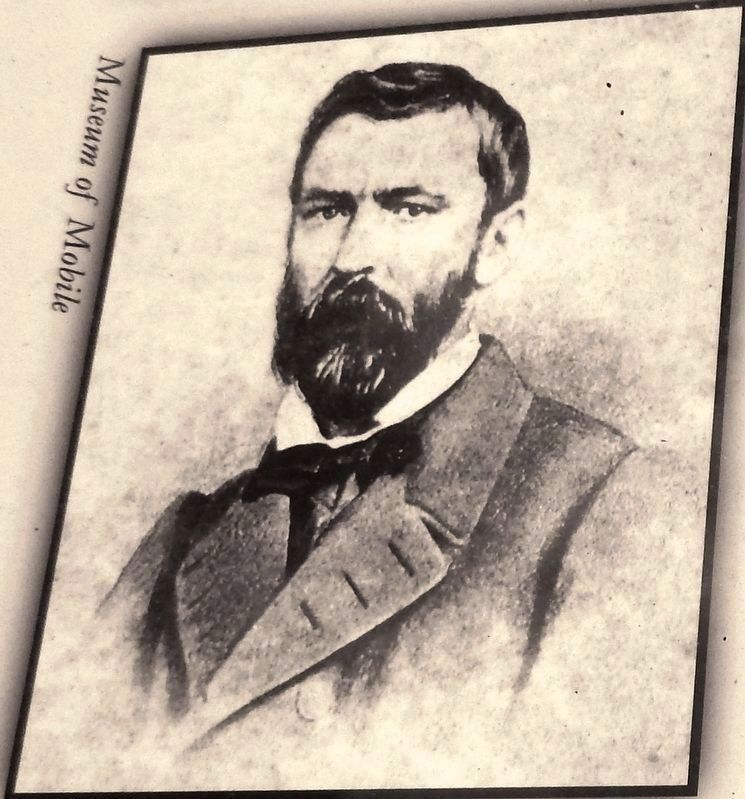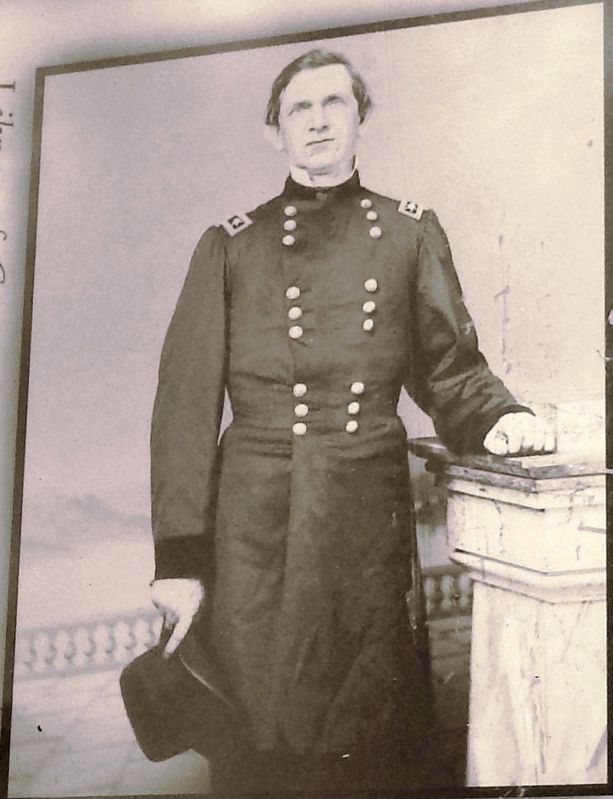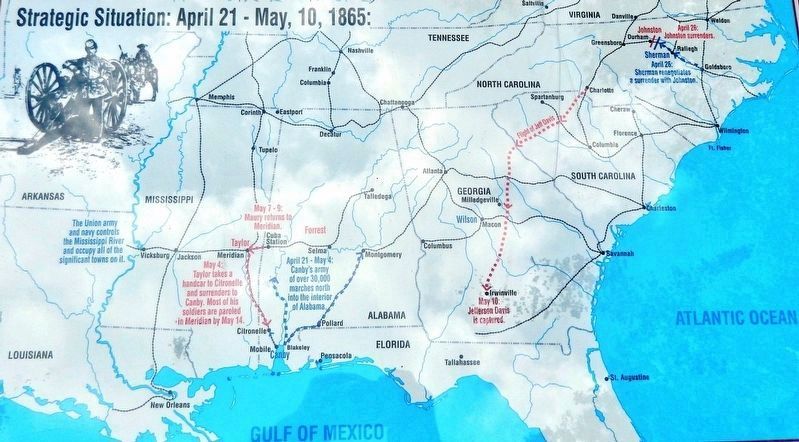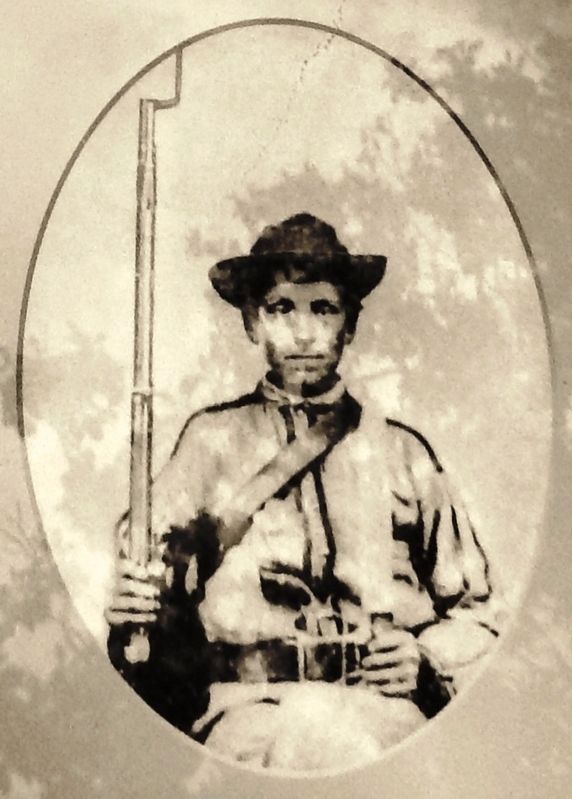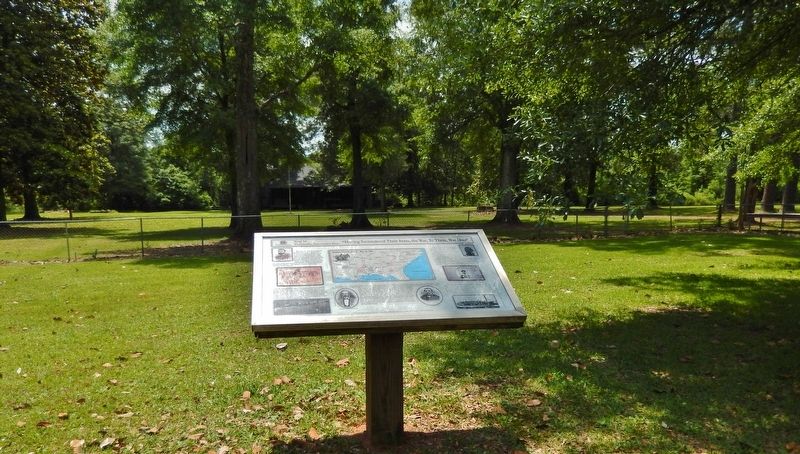Citronelle in Mobile County, Alabama — The American South (East South Central)
"Having Surrendered Their Arms, the War, to Them, Was Over"
Citronelle, Surrender Site
— The Battle of Mobile Bay Civil War Trail —
Inscription.
On April 30, 1865, C.S. General Richard Taylor, by then back in Meridian, received a wire from U. S. General Edward Canby. The truce negotiated at Magee Farm, Canby informed him, must end in 48 hours, because Washington had rejected the Johnston-Sherman Contention on which it was based. However, Canby would accept Taylor's surrender on the same terms that Grant had offered Lee. Soon after, Taylor learned that Johnston had agreed to Grant's terms and surrendered on April 26.
Virtually surrounded by tens of thousands of bluecoats, Taylor faced a stark choice. He could surrender or divide his army into guerilla bands and continue the fight. Feeling this latter notion absurd, he quickly rejected it, warning a subordinate that any men who attempted this would be “hunted down like beasts of prey…” Taylor had no room to hesitate: “Folly and madness combined would not have justified an attempt to prolong a hopeless contest.” Taylor accepted Canby's proposal on May 2.
Accompanied by Commodore Ebenezer Farrand, the commander of the Mobile naval squadron, Taylor once again took a handcar south from Meridian. Here, on May 4, 1865, he and Farrand met Canby and Admiral Henry Thatcher and surrendered their army and naval forces, including their artillery, ordnance, and quartermaster and commissary stores. The surrender, Taylor later recalled, was on terms consistent with the honor of Confederate arms. Officers were allowed to keep their side arms and mounted men, their horses. The men's paroles would be signed by their own officers and turned over to Federal officers by them. Taylor, who was to be given food to feed his men, also retained control of the railways and river steamers so his troops could get home. Finally, Canby agreed to send officers to Meridian to receive the Confederate paroles and stores. Taylor appreciated Canby's goodwill and generosity and Canby, in turn, found Taylor to be helpful with advice and scrupulously honest in the execution of their agreement.
Farrand's squadron surrendered to U.S. Naval personnel on the Tombigbee River between May 10 and 11. On May 5 Maury's men, still at Cuba Station, learned that they had been surrendered as prisoners of war. On the 7th they broke camp and, piling their guns on ordnance wagons or leaning them on trees by the road, returned to Meridian. Arriving on the 9th, they rejoined part of the Blakeley garrison — also there to be paroled. Though deeply saddened by a sense of failure and personal loss, Taylor’s men were relieved to receive their paroles without ceremony, seeing little of the Federal soldiers. By May 14 most of the ex-rebels had broken camp for the last time. Many embarked on river steamers and returned to Mobile in the company of numerous Yankees.
”The men that hailed us from these crowded decks wore the dress with which we were familiar. In lieu of defiant shouts and musket volleys, they hailed and were greeted as friends. Having surrendered their arms, the war, to them, was over, and all its bitterness past and buried. With that frank, courtly regard which the brave entertain for those they have tried by fire, no time was lost in establishing the most friendly feeling between the ‘blue and the gray.’”
J.T. Woods, Surgeon, 99th Ohio Infantry
Erected by Battle of Mobile Bay Civil War Trail. (Marker Number 14.)
Topics. This historical marker is listed in this topic list: War, US Civil. A significant historical date for this entry is April 30, 1865.
Location. 31° 4.502′ N, 88° 14.018′ W. Marker is in Citronelle, Alabama, in Mobile County. Marker is on Celeste Road (County Route 41) 0.3 miles north of Boy Scout Road, on the right when traveling north. Marker is located in a small roadside park on the Boy Scout Camp Pushmataha grounds. Turn in at the Camp Pushmataha sign to access the marker. Touch for map. Marker is in this post office area: Citronelle AL 36522, United States of America. Touch for directions.
Other nearby markers. At least 4 other markers are within 18 miles of this marker, measured as the crow flies. Surrender Site (a few steps from this marker); MOWA Band of Choctaw Indians (approx. 11.1 miles away); Andrews Chapel (approx. 17.7 miles away); Town of McIntosh (approx. 17.9 miles away).
More about this marker. The Battle of Mobile Bay Civil War Trail comprises more than a dozen sites where action took place during both the Battle of Mobile Bay and the Overland Campaign. The stories of ship captains, fort commanders and common fighting men are told through first hand accounts, historical references and detailed illustrations displayed on interpretive signs placed at many of the sites along the trail.
Regarding "Having Surrendered Their Arms, the War, to Them, Was Over". The last surrender of the Confederate Army, east of the Mississippi River, occurred in Citronelle on May 4, 1865. This last army of close to 9,000 Confederate soldiers was surrendered on the 4th of May, 1865 by its Commander, General Richard (Dick) Taylor, to the U.S. Army General, E.R.S. Canby under a large white oak tree in Citronelle.
Related markers. Click here for a list of markers that are related to this marker. Citronelle, Alabama Surrender Site
Also see . . .
1. Confederate Lt. General Richard Taylor Surrenders In Citronelle Alabama. Exploros website entry:
Taylor
agreed to meet Union Major General E.R.S. Canby for a conference a few miles north of Mobile at Magee Farm, in the town of Kushla, on April 30th at which time they established a truce, terminable after 48 hours notice by either party. The Confederate general arrived at Magee Farm on a handcar propelled by two African Americans. A single officer, Colonel William Levy, accompanied them. General Canby, on the other hand, reached the meeting place accompanied by his staff in dress uniforms, a full brigade of Union troops and a military band. (Submitted on November 25, 2018, by Cosmos Mariner of Cape Canaveral, Florida.)
2. Surrender at Citronelle. Explore Southern history website entry (Submitted on November 10, 2023, by Larry Gertner of New York, New York.)
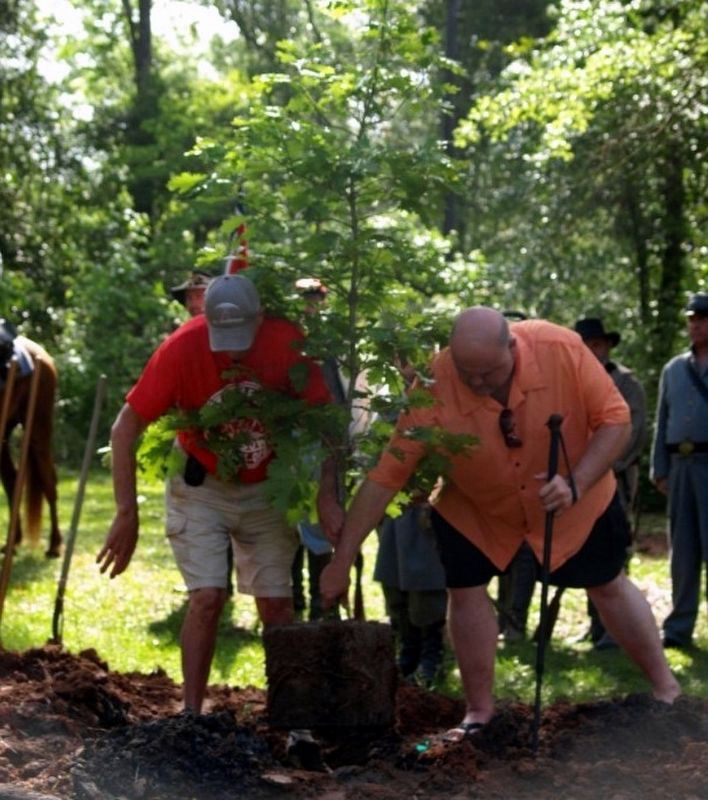
via Citronelle Historical Preservation Society, 2012
7. 2012 Surrender Oak Festival: Tree Planting Ceremony
Citronelle Historical Preservation Society website entry:
Gordon Vernon, (right) President of the Citronelle Historical Preservation Society assists former Citronelle Mayor Rannel Presnell in planting a symbolic Surrender Oak Tree at Camp Pushmataha at the site of the original Surrender Oak under which Confederate forces surrendered to Union forces on May 4, 1965. The original Surrender Oak was blown down during the Hurricane of 1906. From it were made many souvenirs; some of which were sent to the Smithsonian Institute.
Click for more information.
Gordon Vernon, (right) President of the Citronelle Historical Preservation Society assists former Citronelle Mayor Rannel Presnell in planting a symbolic Surrender Oak Tree at Camp Pushmataha at the site of the original Surrender Oak under which Confederate forces surrendered to Union forces on May 4, 1965. The original Surrender Oak was blown down during the Hurricane of 1906. From it were made many souvenirs; some of which were sent to the Smithsonian Institute.
Click for more information.
Credits. This page was last revised on November 10, 2023. It was originally submitted on November 23, 2018, by Cosmos Mariner of Cape Canaveral, Florida. This page has been viewed 1,513 times since then and 102 times this year. It was the Marker of the Week April 30, 2023. Photos: 1, 2, 3, 4, 5, 6. submitted on November 25, 2018, by Cosmos Mariner of Cape Canaveral, Florida. 7. submitted on June 4, 2021, by Larry Gertner of New York, New York. • Bernard Fisher was the editor who published this page.
